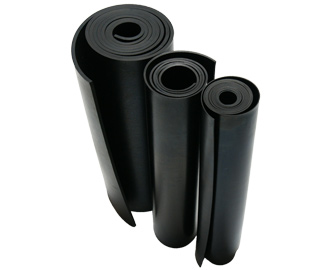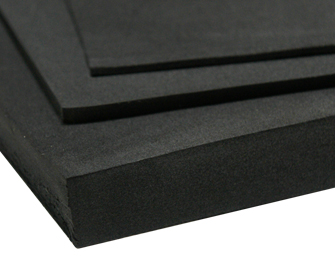|
|
Neoprene foam sheets, especially closed cell neoprene, are popularly used in sealing and gasketing applications. Although they are porous in nature, neoprene foam sheets can provide ample protection in a multitude of light to medium-duty applications in both indoor and outdoor settings. In addition, closed cell neoprene is highly resistant to oil, chemicals, heat, and moisture allowing them to be used in settings most materials cannot withstand. Furthermore, foam neoprene padding is a less dense material than solid neoprene meaning it can withstand more pressure and compression which, in turn, gives them a longer life compared to solid materials. Neoprene foam sheets are highly valued in industrial workplaces and are frequently used for abrasive applications involving heat, moisture, chemicals, and oil.
How is Neoprene Foam Made?
Neoprene foam sheets are made by introducing nitrogen gas into the material before going through vulcanization during its production process. There are two types of neoprene foam: closed cell and open cell. The main difference between the two forms is found within their compositions which are created using two different methods. For instance, “Closed foam sheets are usually made by introducing rubber compound to a gas, such as nitrogen, under high pressure” (rubberlibrary.com). This makes closed cell neoprene foam a lighter and more porous material than solid neoprene rubber, but has a tight-knit cellular structure. On the other hand, open cell neoprene foam contains larger air pockets which makes it airier and less dense. Open cell neoprene foam “is made by introducing an inflating agent into the rubber compound which expands during vulcanization” (rubberlibrary.com). Closed cell neoprene foam is a denser and more resilient material than open cell neoprene foam and is highly valued in industrial settings.
What is Closed Cell Neoprene Foam?
Closed cell neoprene foam is a cellular form of neoprene rubber that is characterized by its tightly knit pockets of air. It is lighter than solid neoprene rubber sheeting and “is defined by its walls and not interconnecting with other cells” (rubberlibrary.com). Due to its tight-knit cellular structure, closed cell neoprene foam is much denser that open cell neoprene foam and is still moderately resistant to staining or damage caused by exposure to oil or gas. Closed cell neoprene foam also retains a high operating temperature of up to 200 degrees Fahrenheit allowing for applications involving abrasively high temperatures. Furthermore, closed cell foam, like its solid form, is also resistant to outside damaging factors, such as direct sunlight, ozone, oxygen, and water (both fresh and sea water) allowing it to be a more versatile material than open cell neoprene foam.
Is Neoprene Foam Waterproof?
Neoprene foam sheets are not 100% waterproof, especially open cell neoprene foam; however, closed cell neoprene foam is highly moisture-resistant with an absorption level of less than 5%. Despite its porous nature, close cell neoprene foam will resist the penetration of moisture to a certain degree due to its structure. Its tight-knit cellular structure makes it extremely difficult for moisture to permeate through the material and will actually float on water. This is due to its closely knit pockets of air which creates a denser and less airy material. Open cell neoprene foam, in contrast, does not have a tight knit cellular structure and will easily absorb moisture upon contact. Although closed cell neoprene foam is highly water-resistant, it is still a porous and semi-permeable material that will absorb moisture if it is left unattended for long periods of time.
What is Closed Cell Neoprene Used For?
Closed cell neoprene foam is a cellular variation of neoprene rubber that is often used for marine/moisture-heavy, sound reduction, and highly compressive application due to its tight-knit porous and water-resistant structure. Due to its tight-knit porous nature, closed cell foam is a softer and more compressive material that its solid form; however, it still retains a high working temperature of up to 200 degrees Fahrenheit. Additionally, since closed cell neoprene foam sheets are also oil, chemical, and grease-resistant, they can be used for industrial applications involving these harsh solvents. Closed cell neoprene foam is a durable and resilient material that can be used for abrasive applications in industrial settings.
Marine/Moisture-Heavy Applications
Due to closed cell foam’s resistance to moisture, it is a popular material used for marine applications or for applications involving moisture. Closed cell neoprene foam sheets can be used in outdoor marine settings as padding or cushioning for boat floors because of its ability to withstand outdoor conditions and resist both fresh and salt water without deteriorating. Other times, closed cell neoprene foam is used for more common applications such as car window seals. Outdoor industrial settings can benefit from the use of neoprene foam sheets as electrical insulators. Water is one of the most common conductors of electricity due to the charged ions found in tap water. The presence of moisture around open wires or electricity operated machinery can cause serious electrical hazards for industrial workers. Neoprene foam sheets will not be damaged by the heat generated by the flow of electricity making it a reliable protective covering for electrical appliances.

|

|
Sound Dampening Applications
Neoprene foam sheets with closed cells are able to effectively dampen the amount of noise generated by moving objects or vibrations due to its dense structure. Closed cellular neoprene padding is designed to act as a barrier between moving objects and hard surfaces. Due to close cell neoprene foam’s porous structure, it is able to better disperse the energy of sound within its airy structure to dampen the amount of noise created. Foam neoprene padding can be placed directly under the object that is producing noise or it can be used to line an entire room for all-around noise reduction. Placing foam neoprene padding underneath heavy objects will not deform the material; instead, the material will return to its original form when the pressure is removed from its surface. When it comes to noise reduction, closed cell neoprene foam is the better option over solid neoprene sheets.
Compressive Applications
Closed cell neoprene foam is a softer and less dense material, when compared to solid neoprene sheets, which gives it a lower compression set. Solid neoprene sheeting also retains a low compression set; however, because they are denser materials, they will not be as compressive as neoprene foam sheets. There are many scales used to measure the hardness of various materials, but neoprene foam sheets are measured using the Shore C scale because it is the scale used to measure soft rubber, urethane foams, and rubber rollers (hoto-instruments.com). When reading the durometer rating, it is important to know that higher durometer means harder material. Closed cell neoprene foam has a durometer rating of 20-25 Shore C making it an ideal material for making a neoprene foam gasket for highly compressive applications. It is a far less dense material than solid neoprene rolls and is often used to make a neoprene foam gasket or pad for industrial settings. A neoprene foam gasket is oil, heat, and moisture-resistant product that is ideal for abrasive industrial applications. Additionally, a neoprene foam gasket will last for longer periods of time because its high compressibility slows down wear and tear giving it longer life.

|

|
Due to closed cell neoprene foam’s tight-knit cellular structure, it is a popular material use in abrasive or highly compressed applications. Its cellular structure allows it to retain a longer life in highly compressive applications while also being dense enough to resist damage caused heat, moisture, oils, and chemicals. These properties of close cell neoprene also help create a reliable application that will promote a safe industrial work environment. Additionally, foam neoprene padding can be used to help reduce the amount of noise created by vibration or moving machinery by being able to better distribute sound within its cellular structure. Neoprene foam sheets can offer a long-lasting and reliable option for use in industrial settings.
What is Closed Cell Neoprene Foam?
|
|
|